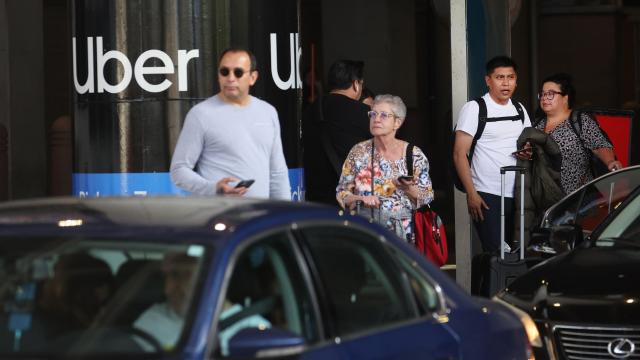It seems Uber just isn’t content with letting users travel in peace and awkward silence during their point-to-point trips. The ride-hailing company now plans to advertise to users at every point of a trip from the moment you open the app. These ads will potentially appear on multiple screens, blasting consumers with new products with the same subtlety as a clown following the car on a kid-sized tricycle trying to get your attention through the car window.
These so-called “Journey Ads” are meant to hit riders throughout the process of getting an Uber, including requesting the ride, waiting for the ride, and even when you’re actually sitting down in the car. These will be restricted to a single advertiser, meaning users will see the same product again and again while they simply try to get from one place to another. The company made it clear they will use “first party data” for targeted advertising.
But that’s not all. Uber announced Wednesday their brand spanking new advertising division also plans to place sponsored listings on the Uber Eats app, post-checkout ads after users place an order, in-menu ads when you’re deciding on an Uber Eats order, billboard ads on the Uber Eats homepage, along with a host of other sponsored emails, storefront ads, and more. The eye-numbingly long list of new advertising efforts even include a pilot to host targeted ads on in-car tablets being propositioned in Los Angeles and San Francisco, California.
So if you’re planning to hit up a bar, expect to see a beer brand bombarding you with ads for their latest way to get sloshed. Taking a trip to the beach? Well how about some brand-name sunscreen. The possibilities are endless, and Uber is advertising that users will reportedly be able to remain in the Uber app while they purchase an advertised product.
Though Uber may come into conflict with regulators for its use of geolocation data in order to advertise to consumers. In August, the FTC sued the data broker Kochava, alleging they were breaking the law for selling location data on “hundreds of millions of people.” Location data included visits to addiction recovery centres and reproductive health clinics, which is an especially threatening proposition after the end of Roe v. Wade’s abortion protections.
An Uber spokesperson told The Wall Street Journal that the company only uses aggregated information from users. Uber’s general manager for their advertising Division Mark Grether, meanwhile mentioned that users can opt out of targeted ads through the Uber app. The company’s advertising policies restrict it from having ads based on visits to reproductive health centres, as well as medical centres, schools, government buildings, or even “adult entertainment.”
Even if you trust Uber to not go against its own policy, that aggregated data can still be used by both advertisers and outside data brokers to link it back to individual users. Advertisers may be restricted in what and to whom they can advertise, but outside agencies with access to this data certainly aren’t.
And they’re not the only ones seeing more room to advertise to consumers at every possible moment. Uber’s main competitor Lyft announced in August they were diving into in-car ads through its own ad component called Lyft Media. The fellow ride hail app mentioned they were adding more ads to Lyft’s in-car tablets in Chicago, Washington D.C., and San Francisco, having already piloted the project with Lyfts in Los Angeles.
Uber is not holding back from targeted advertising at any point during the process of using their apps. In the company’s release Grether said, “While these consumers are making purchase decisions and waiting for their destination or delivery we can engage them with messages from brands that are relevant to their purchase journeys. And with 1.87 billion trips last quarter, that means we can connect advertisers to consumers on average five times per month across rides and delivery.”
Grether mentioned to Business Insider that the ads would eventually make rides cheaper, but he did not exactly say by how much. Gizmodo reached out to Uber for any more details as to whether these ads will be factored into the company’s pricing strategy, but we did not immediately hear back.
Uber already has brands like Heineken, Shake Shack, and NBCUniversal ready to shove images of sickly-green beers or the next episode of The Voice in your face. Uber declined to tell Insider how much these companies may be paying for Journey Ads, but it’s apparently enough that the ride hailing company said it hopes to make $US1 ($1) billion in revenue by 2024. The fee will depend on the “type” of user the advertiser is trying to target.
The man who often goes by Dr. Grether joined Uber last year after years of experience at Amazon and his own company Sizmek. He told the Journal that cars are becoming “our living rooms,” apparently thinking the advent of micro mobility platforms and autopilot vehicles will give us more room to stare at screens and imbibe even more ads.
Uber has struggled to keep user data secure. A recent hack of Uber’s system forced the company to state that user data remained secure. The company has failed to prevent a previous loss of 57 million users’ data, and one of the company’s former security chiefs was recently convicted of hiding a massive 2016 breach of user data from authorities.
